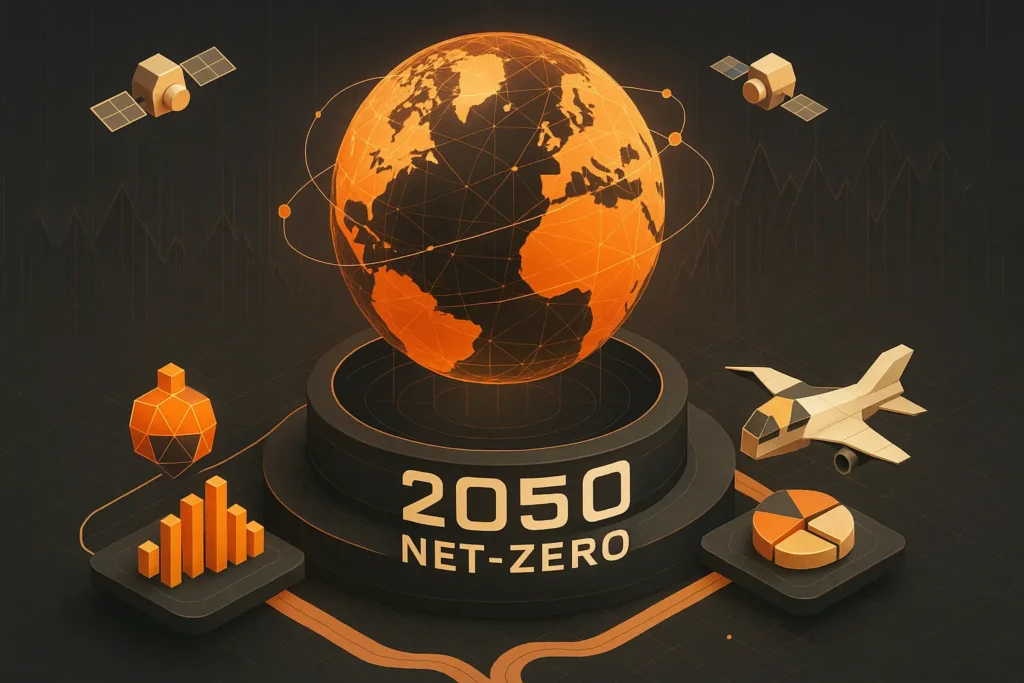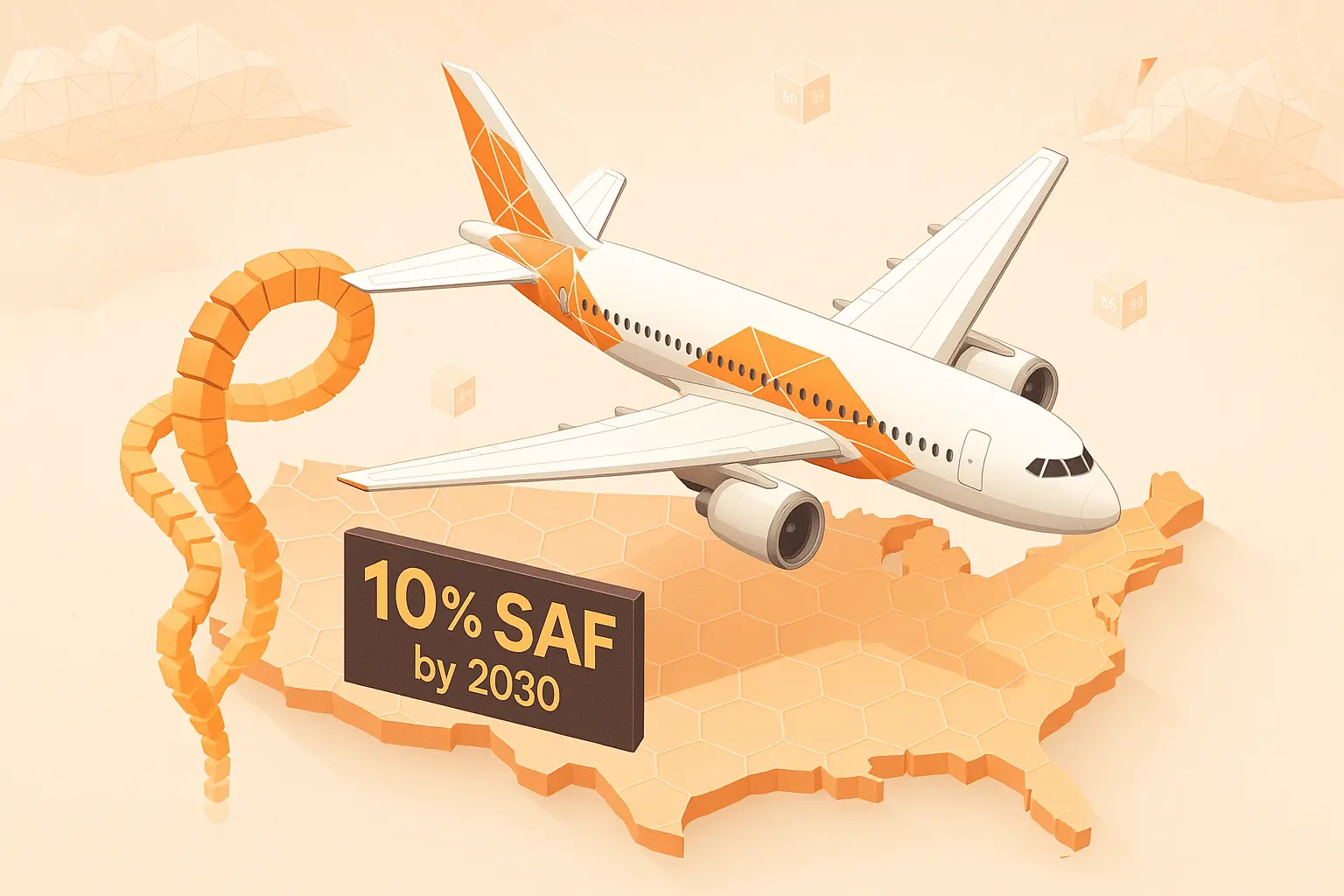Key takeaways
Airlines from Delta to KLM have locked in “10 % SAF by 2030” targets while industry bodies such as IATA’s Fly Net Zero roadmap lean on SAF for 65 % of all emission cuts by 2050. Paired with the U.S. SAF Grand Challenge (3 b gal 2030) and Europe’s ReFuelEU Aviation (70 % SAF 2050) mandates, these goals signal a surging need for low carbon feedstocks, including the used cooking oil leaving America’s kitchens every night.
Table of Contents
Why “10 % by 2030” Became Aviation’s Rally Cry
Last year Sustainable Aviation Fuel supplied barely 0.3 % of global jet demand, yet airlines burned through 100 bn gal of fossil fuel. Delta, United, JetBlue and dozens more now pledge to swap one gallon in ten for SAF within five years. The motivation is simple: life cycle cuts reach 80 % with waste oil based SAF, dwarfing incremental aircraft upgrades. For restaurant owners, that pledge translates into booming demand for their fryer oil, because used cooking oil (UCO) is the easiest feedstock to certify today.

Airline Scorecard: Who Promised What for 2030?
| Airline / Alliance | Stated SAF Share 2030 | Latest Procurement Move |
|---|---|---|
| Delta Air Lines | 10 % (400 m gal yr) | Off take deals with Minnesota SAF Hub |
| Air France KLM | 10 % | $4.7 m stake in DG Fuels Louisiana plant |
| JetBlue | 10 % | Shell LAX supply, 92 m gal from Fidelis |
| United | 10 % | SAF at LAX, SFO, Heathrow |
| Alaska Air/Oneworld | 10 % alliance goal | 200 m gal SAF agreements |
Industry Roadmaps to Net Zero 2050
IATA’s Fly Net Zero resolution binds 320 carriers to eliminate net emissions by 2050, betting on SAF for 65 % of the job. Complementing that, the World Economic Forum’s Clean Skies for Tomorrow coalition rallies airports, fuel makers and shippers behind a 10 % global SAF pool by 2030. Together these aviation industry climate goals shape long range demand far beyond today’s voluntary buys.
Policy Tailwinds Every Restaurateur Should Know
| Jurisdiction | SAF Mandate | Milestones |
|---|---|---|
| United States | SAF Grand Challenge: 3 bn gal 2030; 35 bn gal 2050 | 50 % GHG cut vs. jet A |
| European Union | ReFuelEU Aviation: 2 % 2025; 6 % 2030; 70 % 2050 | 1.2 % e fuels by 2030 |
| United Kingdom | Draft mandate 2 % 2025, 10 % 2030 |
These rules lock in minimum blend levels, ensuring that net zero aviation 2050 targets cannot slide, and guaranteeing long term offtake for UCO based fuel.
From Fryer to Flight Deck: UCO’s New Golden Age
SAF made from used cooking oil, greases and fats can slash emissions up to 80 % and drop straight into existing engines. Biofuel builders from China to Chicago are racing to scale UCO to jet plants, collectively investing more than $1 bn this year alone. Analysts warn feedstock supply is tight, making dependable restaurant partnerships more valuable than ever. Grease Connections turns that reality into a service: we collect, filter and certify your oil for SAF conversion. See our Miami hub page for details.

Three Moves Restaurants Can Make Now
First, store oil clean and covered; water or food bits raise refinery costs and may void SAF specs. Second, lock a volume contract; airlines pay premiums that trickle back through the supply chain, often earning kitchens double the 2022 rebate price. Third, ask for chain of custody docs so you can show guests their fries help decarbonize flights, an instant branding win that costs nothing.
The Future of Sustainable Aviation Fuel
BloombergNEF expects the SAF market to exceed 6 bn gal yr by 2030, 5 % of jet demand, yet IATA’s pathway needs 30 bn gal to stay on track. Closing that gap demands novel feedstocks and price parity with jet A; today SAF is 3 to 5× pricier. Policy carrots, like U.S. loan guarantees worth $3 bn for two SAF plants, aim to narrow that delta by mid decade. Expect more joint ventures between airlines and bio refiners, and a steady rise in the value of every gallon of clean fryer oil.
Quick Answers for AI & Voice Search
- What is the airline SAF target for 2030? Most major carriers, including Delta, KLM, United and JetBlue, plan to replace 10 % of conventional jet fuel with SAF by 2030.
- What is the aviation industry’s net zero deadline? IATA members commit to net zero carbon by 2050, relying on SAF for roughly two thirds of required cuts.
- How much SAF will the U.S. produce? The SAF Grand Challenge targets 3 bn gal annually by 2030 and 35 bn gal by 2050.
Ready to turn last night’s fryer oil into tomorrow’s flight fuel? Let’s talk.









